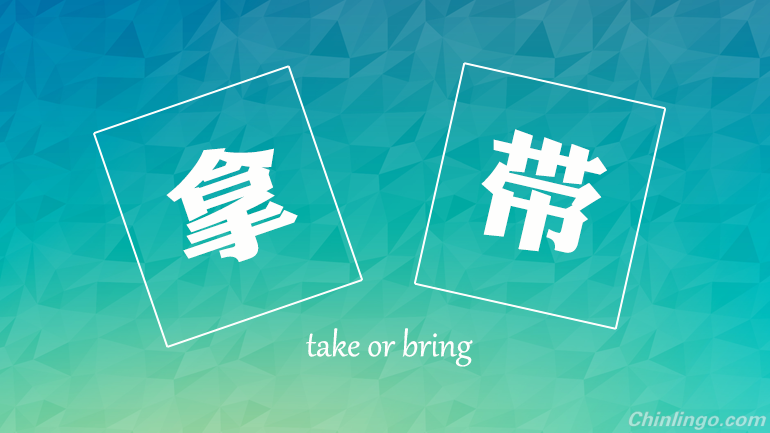
The verbs 拿 (ná) and 带 (dài) can both mean "bring" or "take", so what is the difference between the two? In short, the difference between 拿 and 带 is:
中文里的动词"拿"和"带"都可以表示"bring"或"take"的意思,因此它们之间有什么不同之处呢?简而言之,"拿"和"带"的不同之处在于:
拿 focuses on the action of carrying or picking up an object, particularly in one's hands.
"拿"主要用于携带、收取东西的动作,尤其是指用手携带。
带 focuses on bringing or taking things with you, i.e. having something whilst moving.
"带"主要用于"带来"或随身携带,如移动过程中还带着某物。
Comparing 拿 and 带 directly
The best way to get an idea of the difference between 拿 and 带 is probably to compare them in identical sentences.
区分"拿"和"带"的最好方法或许是在完全相同的句子里进行比较。
你能带多少行李?
Nǐ néng dài duōshǎo xínglǐ?
How much luggage are you allowed to take?
你能拿多少行李?
Nǐ néng ná duōshǎo xínglǐ?
How much luggage can you carry?
Here you can see that whilst 带 and 拿 can both mean ‘take', 带 simply expresses the act of moving with an object, whereas 拿 focuses on the physical act of carrying it.
这里你可以看到"带"和"拿"都可以表示"take"的意思。"带"仅仅是表达了移动过程中带着东西的行为,而"拿"则集中在"携带"这个身体动作。
拿(ná)
拿 is used to talk about physically picking things up or carrying them. When 拿 is used, you can always think of things being moved in someone's hands.
"拿"是用于说明拿取或携带东西的身体动作。用"拿"的时候,你可以想象东西被某人用手拿住的场景。
Taking to and from with 拿
Depending on the direction of the action, 拿 is often translated into "bring" or "take" in English. Let's have a look at "take" first:
"拿"在英语里常常译成"bring"或者"take",这取决于动作的指向。先看看表示"take"的例子:
他从书架上拿下来了一本书。
Tā cóng shūjià shàng ná xiàláile yī běn shū.
He took a book down from the bookshelf.
你应该拿到前台去吧。
Nǐ yīnggāi ná dào qiántái qù ba.
You should take it to the front desk.
Bringing to and from with 拿
You can also use 拿 to talk about bringing things to or from places:
你也可以用"拿"表示带某物到某处或者从某地带来某物:
你可以拿点吃的来吗?
Nǐ kěyǐ ná diǎn chī de lái ma?
Could you bring some food?
他从家里拿来了一瓶红酒。
Tā cóng jiālǐ ná láile yī píng hóngjiǔ.
He brought a bottle of red wine from home.
Getting or acquiring with 拿
As well as talking about physically moving things around, 拿 can also be used to talk about ‘getting' or ‘acquiring' things.
"拿"既可以表示身体上随地移动物体,也可以用于表示"得到"或"获取"某物。
我拿到了签证就可以去。
Wǒ ná dàole qiānzhèng jiù kěyǐ qù.
I can go once I've got my visa.
我会在机场柜台拿机票。
Wǒ huì zài jīchǎng guìtái ná jīpiào.
I'll pick my ticket up at the airport counter.
带 (dài)
Taking to and from with 带
As with 拿, whether 带 is translated into ‘bring' or ‘take' in English is decided by the direction of the movement. Chinese uses 带 for both directions:
和"拿"一样,"带"在英文里译成"bring"或"take"取决于移动的方向。中文里"带"可用于两个方向。
你带这个去送给他们吧。
Nǐ dài zhège qù sòng gěi tāmen ba.
Take this and give it to them.
我把这个带走可以吗?
Wǒ bǎ zhège dài zǒu kěyǐ ma?
Is it alright if I take this with me?
Bringing to and from with 带
If the direction is towards the speaker, then 带 becomes ‘bring' rather than ‘take':
要是方向指向的是说话者,那么"带"的意思则是"bring"而不是"take"了:
我没带在身上。
Wǒ mò dài zài shēnshang.
I haven't brought it with me.
你带伞了吗?
Nǐ dài sǎnle ma?
Did you bring an umbrella?
带 can be used with abstract / intangible things
Finally, another difference between 拿 and 带 is that 带 can be used with abstract or intangible things, whereas this doesn't tend to be the case with 拿.
最后,"拿"和"带"之间的另一个不同点是"带"可用在抽象或无形的物体上,而"拿"不能用于这类情况。
Have a look at some examples:
看看一些例子:
他带着奇怪的眼神看着我。
Tā dàizhe qíguài de yǎnshén kànzhe wǒ.
He looked at me strangely.
她说话是带着浓重的美国口音。
Tā shuōhuà shì dàizhe nóngzhòng dì měiguó kǒuyīn.
She spoke with a thick American accent.
他脸上带着灿烂的笑容。
Tā liǎn shàng dàizhe cànlàn de xiàoróng.
He had a beaming smile on his face.



 闽公网安备 35020302035673号
闽公网安备 35020302035673号
0 responses on "The differences between "拿" and "带" in Chinese"